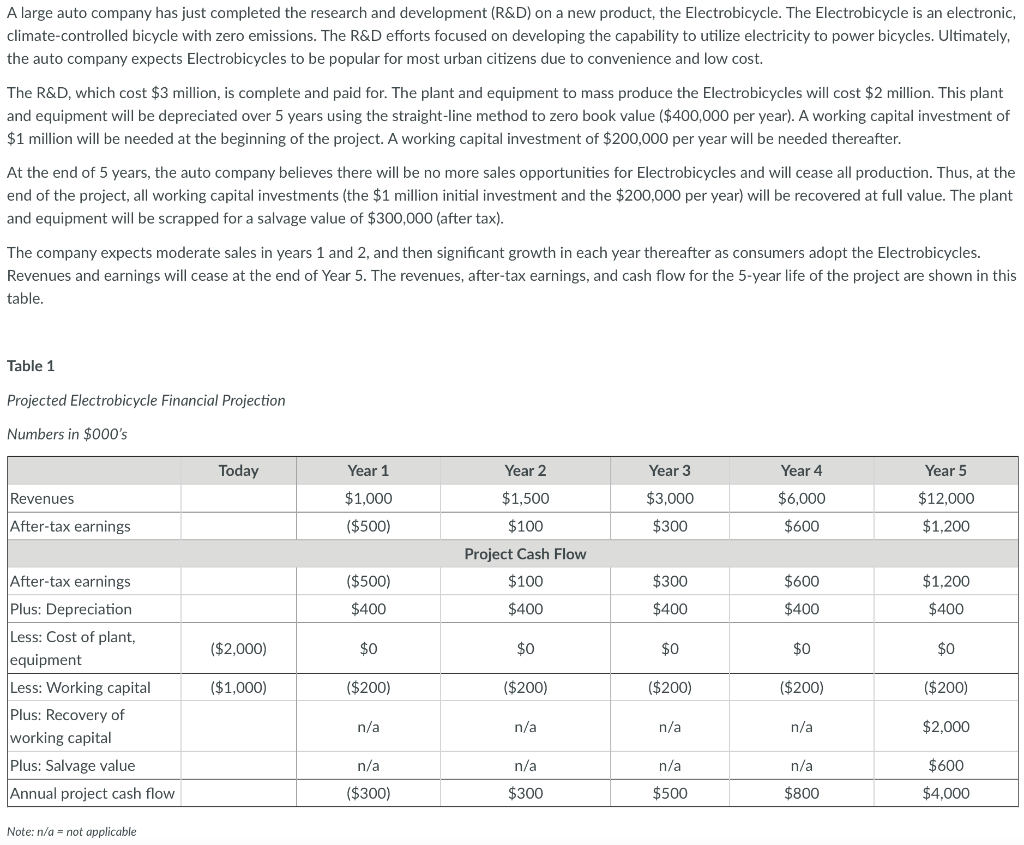Answered step by step
Verified Expert Solution
Question
1 Approved Answer
NPV of the Electrobicycle project NPV=3,000+(1+.29)1300+(1+.29)2300+(1+.29)2500+(1+.29)2800+(1+.29)24,000 NPV= -1,410.75 Assume the auto company has a required rate of return of 15%. Based on the required rate

NPV of the Electrobicycle project
NPV=3,000+(1+.29)1300+(1+.29)2300+(1+.29)2500+(1+.29)2800+(1+.29)24,000
NPV= -1,410.75
- Assume the auto company has a required rate of return of 15%. Based on the required rate of return you used for the Electrobicycles (29%), is the Electrobicycle project more or less risky than the auto company? Explain your answer.
A large auto company has just completed the research and development (R&D) on a new product, the Electrobicycle. The Electrobicycle is an electronic, climate-controlled bicycle with zero emissions. The R&D efforts focused on developing the capability to utilize electricity to power bicycles. Ultimately, the auto company expects Electrobicycles to be popular for most urban citizens due to convenience and low cost. The R&D, which cost $3 million, is complete and paid for. The plant and equipment to mass produce the Electrobicycles will cost $2 million. This plant and equipment will be depreciated over 5 years using the straight-line method to zero book value ($400,000 per year). A working capital investment of $1 million will be needed at the beginning of the project. A working capital investment of $200,000 per year will be needed thereafter. At the end of 5 years, the auto company believes there will be no more sales opportunities for Electrobicycles and will cease all production. Thus, at the end of the project, all working capital investments (the $1 million initial investment and the $200,000 per year) will be recovered at full value. The plant and equipment will be scrapped for a salvage value of $300,000 (after tax). The company expects moderate sales in years 1 and 2, and then significant growth in each year thereafter as consumers adopt the Electrobicycles. Revenues and earnings will cease at the end of Year 5. The revenues, after-tax earnings, and cash flow for the 5-year life of the project are shown in this table. Table 1 Projected Electrobicycle Financial Projection Numbers in $000's Today Year 1 Year 3 Year 4 Year 5 Revenues $1,000 Year 2 $1,500 $100 $3,000 $12,000 $6,000 $600 After-tax earnings ($500) $300 $1,200 Project Cash Flow $100 ($500) $300 $600 $1,200 $400 $400 $400 $400 $400 ($2,000) $0 $0 $0 $0 $0 After-tax earnings Plus: Depreciation Less: Cost of plant, equipment Less: Working capital Plus: Recovery of working capital Plus: Salvage value Annual project cash flow ($1,000) ($200) ($200) ($200) ($200) ($200) n/a n/a n/a n/a $2,000 n/a n/a n/a n/a $600 ($300) $300 $500 $800 $4,000 Note: n/a - not applicable A large auto company has just completed the research and development (R&D) on a new product, the Electrobicycle. The Electrobicycle is an electronic, climate-controlled bicycle with zero emissions. The R&D efforts focused on developing the capability to utilize electricity to power bicycles. Ultimately, the auto company expects Electrobicycles to be popular for most urban citizens due to convenience and low cost. The R&D, which cost $3 million, is complete and paid for. The plant and equipment to mass produce the Electrobicycles will cost $2 million. This plant and equipment will be depreciated over 5 years using the straight-line method to zero book value ($400,000 per year). A working capital investment of $1 million will be needed at the beginning of the project. A working capital investment of $200,000 per year will be needed thereafter. At the end of 5 years, the auto company believes there will be no more sales opportunities for Electrobicycles and will cease all production. Thus, at the end of the project, all working capital investments (the $1 million initial investment and the $200,000 per year) will be recovered at full value. The plant and equipment will be scrapped for a salvage value of $300,000 (after tax). The company expects moderate sales in years 1 and 2, and then significant growth in each year thereafter as consumers adopt the Electrobicycles. Revenues and earnings will cease at the end of Year 5. The revenues, after-tax earnings, and cash flow for the 5-year life of the project are shown in this table. Table 1 Projected Electrobicycle Financial Projection Numbers in $000's Today Year 1 Year 3 Year 4 Year 5 Revenues $1,000 Year 2 $1,500 $100 $3,000 $12,000 $6,000 $600 After-tax earnings ($500) $300 $1,200 Project Cash Flow $100 ($500) $300 $600 $1,200 $400 $400 $400 $400 $400 ($2,000) $0 $0 $0 $0 $0 After-tax earnings Plus: Depreciation Less: Cost of plant, equipment Less: Working capital Plus: Recovery of working capital Plus: Salvage value Annual project cash flow ($1,000) ($200) ($200) ($200) ($200) ($200) n/a n/a n/a n/a $2,000 n/a n/a n/a n/a $600 ($300) $300 $500 $800 $4,000 Note: n/a - not applicable
Step by Step Solution
There are 3 Steps involved in it
Step: 1

Get Instant Access to Expert-Tailored Solutions
See step-by-step solutions with expert insights and AI powered tools for academic success
Step: 2

Step: 3

Ace Your Homework with AI
Get the answers you need in no time with our AI-driven, step-by-step assistance
Get Started


